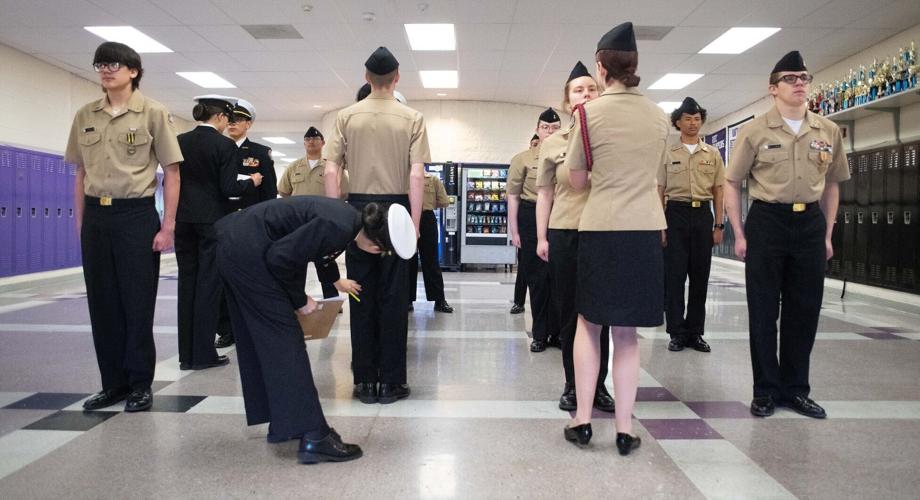Army, Air Force racing to address recruitment; both projected to fall short as eligibility and interest fall
As the Air Force and Army brace to miss recruiting goals this year, both branches are making changes to help address long-term problems of dropping interest and eligibility to serve.
Last year the Army missed its recruiting goal by 25% and doesn’t expect to hit it this year, either, although it is doing statistically better than at this same time last year, spokeswoman Lt. Col. Ruth Castro said. The Air Force met its goals last year, but expected to fall 10% short, the Air Force’s Assistant Secretary Kristyn Jones said in congressional testimony. The Space Force, a much smaller and highly sought after branch, has not seen the same struggles.
Colorado Springs, home to Fort Carson, Peterson and Schriever Space Force bases and the Air Force Academy, has a significant presence of both soldiers and airmen. However, recruiting challenges persist, and both the Army and Air Force are making innovative changes, including a new preparatory program for soldiers who need to lose weight or boost test scores to enlist.
The recruiting shortfalls sweep across most branches and have spurred national calls for action.
“Most of the trends that have created the present recruiting crisis will not change anytime soon, and if left unaddressed, they could soon threaten the ability of the all-volunteer force to protect the nation,” wrote retired Army Lt. Gen. David Barno and Nora Bensahel, visiting professors of studies at the Johns Hopkins School of Advanced International Studies.
The two wrote the military may find itself “continuing to involuntarily shrink” and “may soon be too small to address the growing security challenges facing the United States,” the Washington Examiner reported.
For recruiters, the challenges are numerous because rising obesity and mental health issues are disqualifying more young people from service, while a falling veteran population means that fewer young people are interested in serving.
Military data showed those eligible to serve ages 17 to 24 is down to 23% from 29% in recent years, with 44% ineligible for more than one reason.
In addition to long-term challenges around interest and eligibility, COVID-19 restrictions limited recruiters’ access to schools and many knowledgeable counselors left the field, according to a Fountain-based Air Force recruiter and ROTC scholarship officer at the University of Colorado Colorado Springs.
At the same time, the military is facing larger issues, such as the number of parents who believe their children need to pursue a college degree right out of high school to achieve success, said Katherine Kuzminski, senior fellow and program director with the Center for a New American Security.
“I think (service) used to be almost an exclusive pathway to financial stability and kind of rising through the classes. … Now, there is a variety of ways people can move socioeconomically,” she said.
The military will pay for a college degree, but so will Starbucks and other corporations, she noted. The rising awareness around mental health issues also means far more children and teenagers are receiving diagnosis and care.
She also noted that while a military youth survey showed only 10% of those 16 to 21 years old expected to serve, the majority of people in the military said on that survey they were not interested in serving.
“Recruiters are doing a lot of work,” she said.
Air Force Recruiter Tech. Sgt. Patrick Sullivan who works in Fountain has seen some of the issues firsthand since arriving in the area in December 2020. At the start of the pandemic, graduating seniors already had a plan in place to enlist or commission if they were interested. But younger students didn’t make as many connections with recruiters in schools because they had trouble talking to classes in 2021. Sullivan said he wasn’t fully allowed back in schools until 2022.
He also saw lower scores on the test required to enter the military because of the online learning that followed COVID-19 and a rise in anxiety and depression.
For example, he said out of a group of 10 students about four typically show interest in the Air Force and out of those four, one or two are on medication for anxiety or depression. Those students would need to come off their medications for two years to qualify, he said.
The Air Force has made some changes recently to achieve some quick wins, such as loosening its tattoo policy to allow small hand and neck tattoos, which allowed him to sign up two people in the first few months of the policy change. Over the past five years, he probably turned down five people with small neck tattoos, he said.
“Subtle changes can open up doors for people,” he said.
Less stringent rules on marijuana use have also helped. Currently, prospective recruits need to be clean for 45 days, but sometimes people miscalculate their dates and end up testing positive, he said. A waiver process allows some of those people to test a second time, Sullivan said.
To tackle big issues such as fitness and test scores, the Army, piloted a preparatory program at Fort Jackson, S.C., to help those who don’t have the structure and time needed to meet some military standards around health and academics, said Command Sgt. Maj. Michael Downin, with Army Recruiting Battalion based in Denver. During the program, prospective recruits are paid to prepare for basic training and receive professional assistance losing weight or academic help, he said.
“I think it’s been tremendously successful,” he said.
The course accepted 3,206 students by the end of 2022, and 2,965 students continued on to basic training, according to an Army press release.
Lt. Col. Johnny Fornes with the Denver battalion said the Army is expanding the program and other branches are interested in it.
In addition, the battalion is working to expand its relationships with schools and school leaders, such as principals and guidance counselors, about the diverse and technical career options in the Army.
“There is an information gap across the board,” he said.
Soldiers are also trying work with many different types of events and clubs. For example, soldiers have worked with students interested in health fields to show them how medical soldiers train, he said.
While its true corporations are paying for college degrees, Downin said, they tend to come with a lot of requirements, while for service members those benefits are an entitlement.
In addition, Fornes said there is work to expand JROTC programs in Douglas County and Alamosa. While those programs promote citizenship and awareness about the military, they are not necessarily a pipeline to service, Downin said.
“The vast majority of students in JROTC do not ever join the military,” he said.
On a crisp morning this spring, at the Mesa Ridge High School JROTC program, in response to “Are you ready?” the group of students shouted back “Always ready!” through their workout. JROTC is a citizenship development program, and it does introduce students to the structure and culture of the military, with students taking on military titles and roles within the program.
From among about 100 students in the program, about a third will end up serving, and this year most graduates were headed off to the Army, said Heath Floray, the instructor.
“What we try to do is given as much information as possible so they can make the best informed decision that they can,” he said, that includes offering tours and connections to experts in fields of interest.
Mesa Ridge JROTC student Magdaelema Majerrison expected to enlist in the Army this fall after graduating, to serve as her father did and hopefully travel the world. She was excited rather than nervous for basic training, job skills training, her first duty station and all the new people she expects to meet along the way.
“I’m ready to start the new chapter of my life,” she said.
Her four years in the program also helped her mature and be nicer, said Majerrison, who served as the first lieutenant, in charge of ensuring the classroom was clean and picked up.
“It’s a lot easier to talk to people,” she said.
One of the biggest challenges she sees ahead is running every day early in the morning for basic training, but she said with confidence she expected to get through it and become a military police officer or a armored vehicle driver.
In the long term, she hopes to become an officer, through a program known as Green to Gold that allows enlisted soldiers to earn a college degree and commission as an officer.
“I know that I’m going to be told what to do for a long time. But I like telling people what to do,” she said.









